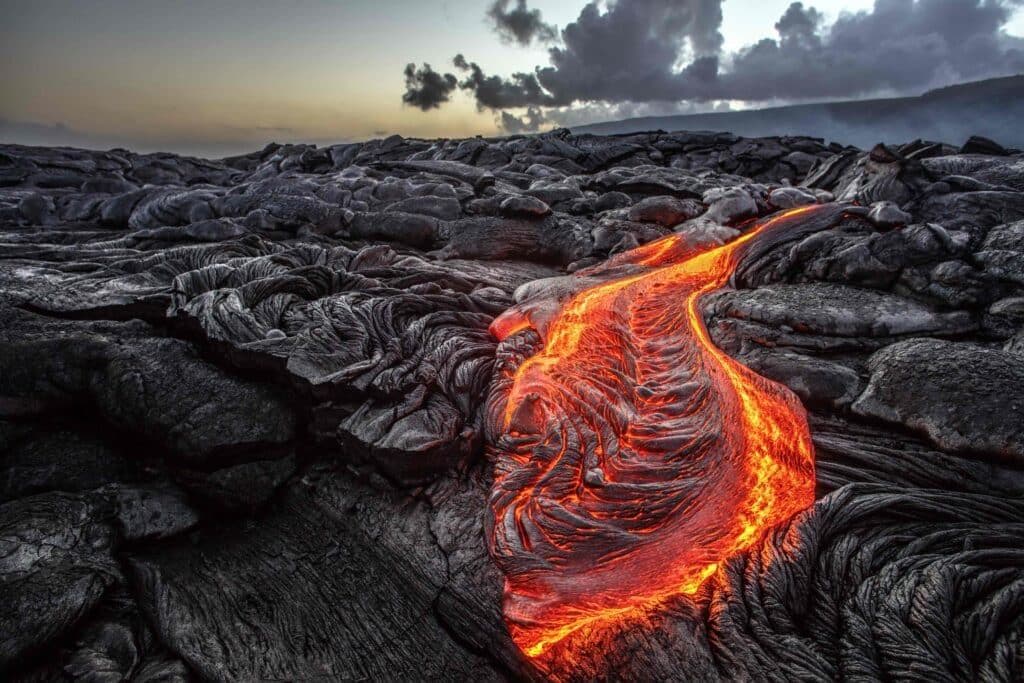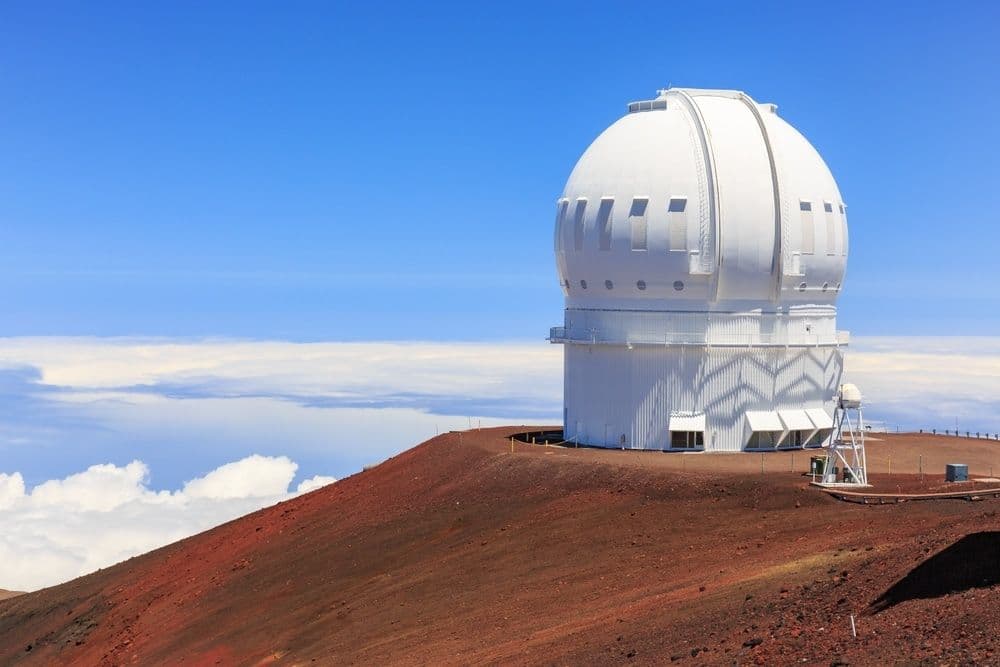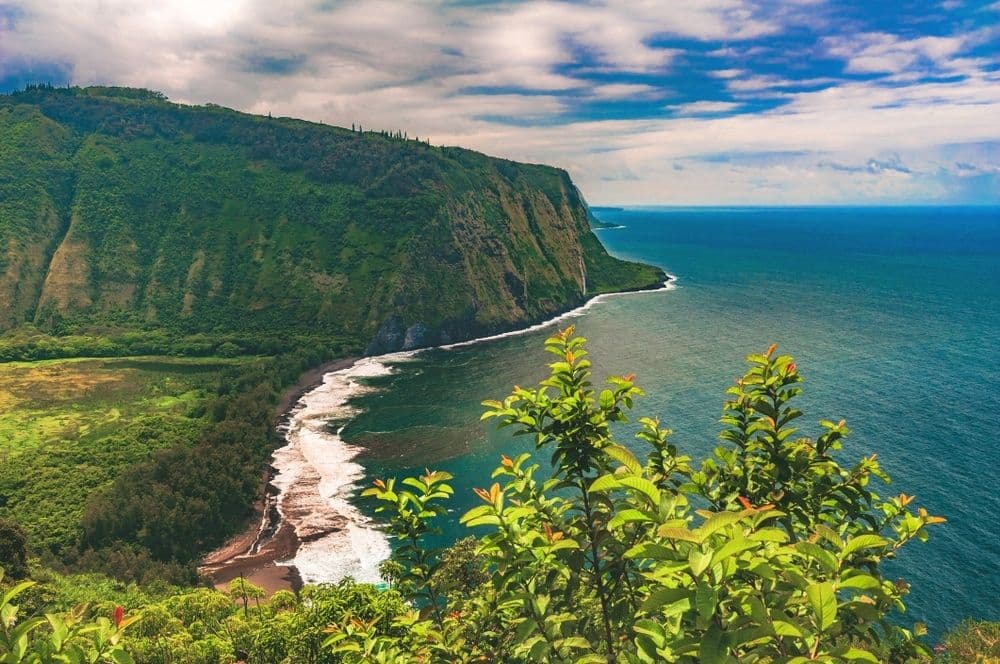By M. Kruse

Hawaii’s Big Island Lava Fields (Photo Credit: Where Earth is Reborn)
The Big Island of Hawai‘i is a land of contrast, where volcanic landscapes meet lush rainforests. Officially known as Hawaiʻi Island, the Big Island is the largest of the Hawaiian Islands and covers more land area than all the other islands combined. One of the most unique aspects of the Big Island is its diverse climate. The island has 11 of the world’s 13 climate zones, ranging from tropical rainforests to arid deserts and even snow-capped mountains. This incredible variety allows visitors to experience black, green, and white sand beaches, explore lava fields, and even witness seasonal snow on Mauna Kea, all in the same day.
Another major distinction of the Big Island is its volcanic activity. Home to Mauna Loa, the largest volcano on Earth by volume, and Kīlauea, one of the most active volcanoes in the world, the island is constantly growing due to ongoing lava flows. Hawaiʻi Volcanoes National Park offers an opportunity to see this dynamic geological activity up close.
Unlike the more densely populated islands like Oʻahu and Maui, the Big Island offers a more laid-back and rural experience. While the island has resort areas such as Kailua-Kona and Waikoloa, much of its charm lies in its small towns, untouched natural beauty, and rich Hawaiian history.
Here are the top things to do on the Big Island that every visitor should have on their bucket list.
A visit to Hawai’i Volcanoes National Park is one of the most thrilling things to do on the Big Island. Witness the sheer power of nature at Kīlauea and Mauna Loa, two of the world’s most famous volcanoes. Take the scenic Crater Rim Drive, hike the Kīlauea Iki Trail, or explore the Thurston Lava Tube. If you’re lucky, you might even see active lava flows! Guided tours are available, and for adventure seekers, helicopter tours are recommended, offering breathtaking aerial views of the park’s volcanic landscapes.
Address: Hawai‘i Volcanoes National Park, HI 96778
More Information: nps.gov/havo
Tips:
Bring a jacket; temperatures drop quickly at higher elevations.
Stop by the Jaggar Museum Overlook for the best view of lava at night.
Start your hikes early to avoid the heat.
“Watching lava glow at night was a surreal experience. This park is a must-visit!” – @travelwithlisa
Kealakekua Bay is one of the best snorkeling spots on the Big Island, a Hawaiian Island known for its unique marine life and natural beauty. This marine sanctuary is home to vibrant coral reefs and an abundance of tropical fish. The bay is also famous for the Captain Cook Monument, a historic landmark. If you’re up for an adventure, kayak tours offer a scenic way to see marine life up close. Book a tour today.
Address: Kealakekua Bay, HI 96704
More Information: DLNR Website
Tips:
Early morning is the best time to snorkel, as the water is calmer.
Avoid stepping on coral to protect the reef ecosystem.
Consider a guided kayak tour for a more immersive experience.
“The water was crystal clear, and we even saw a pod of dolphins! Best snorkeling in Hawaii!” – @oceanadventures
Pro Tip: Help keep the reefs safe by reading up on reef-safe sunscreens.
One of the most unique things to do in Big Island Hawaii is visiting Punalu’u Black Sand Beach, known for its black volcanic sand and Hawaiian green sea turtles. The jet-black volcanic sand, framed by coconut palms, creates a stunning landscape. Keep an eye out for Hawaiian green sea turtles (called honu), which are often spotted basking on the shore. Book a tour here.
Address: Ninole Loop Rd, Pahala, HI 96777
Tips:
Bring reef-safe sunscreen to protect marine life.
Stay at least 10 feet away from sea turtles as they are an endangered species.
Wear sandals, as the black sand can get extremely hot under the sun.
Read our guide to black sand beaches in Hawai‘i.

Waipio Valley Lookout, Hamakua district of the Big Island of Hawai’i
At nearly 13,800 feet, Mauna Kea is the tallest mountain in the world when measured from its base on the ocean floor. More importantly for travelers, it’s one of the best places on Earth for stargazing. With minimal light pollution and crystal-clear skies, the summit offers unparalleled views of the cosmos.
The Mauna Kea Visitor Information Station (VIS), located at 9,200 feet, hosts free stargazing programs where you can use telescopes to observe distant planets, star clusters, and nebulae. Knowledgeable guides provide insight into Hawaiian celestial navigation, which ancient Polynesians used to voyage across the Pacific. For an aerial view, consider taking a helicopter tour of Mauna Kea.
Address: Mauna Kea Access Rd, Hilo, HI 96720
More Information: ifa.hawaii.edu
Tips:
Dress in layers; temperatures can drop below freezing.
Arrive an hour before sunset for the best views.
Acclimate at the visitor center before heading to the summit.
“I’ve never seen so many stars in my life. Absolutely breathtaking!” – @starrytraveler

Waipio Valley Lookout on the Big Island of Hawai’i
One of the most breathtaking road trips on the Big Island is the drive along the Hamakua Coast, a dramatic stretch of Highway 19 between Hilo and Waipiʻo Valley. This journey is filled with lush rainforests, cascading waterfalls, and rugged sea cliffs, making it a must-do for nature lovers and road-trippers alike.
Tips:
Bring a raincoat, as this area gets frequent showers.
Stop at local fruit stands for fresh island treats.
Drive carefully — roads can be narrow and winding.
“Hamakua Coast is a dream road trip — so many hidden gems along the way.” – @pacifictraveler
This sacred site, once a place of refuge for ancient Hawaiian lawbreakers, offers a glimpse into traditional Hawaiian culture. Explore reconstructed temples, wooden carvings, and royal fishponds.
Address: State Hwy 160, Hōnaunau, HI 96726
More Information: National Park Service website
Tips
Arrive early to enjoy the park before the crowds.
Bring water and sunscreen, as parts of the park have little shade.
Respect cultural sites by not touching artifacts or stepping on sacred grounds.
The Big Island’s Kona district is famed for its coffee. Many local farms offer tours where visitors can learn about coffee cultivation and processing, culminating in tastings of the rich, aromatic brew. For a list of farms offering tours, visit the Kona Coffee Farmers Association website.
Tips
Visit in the morning for the freshest coffee beans.
Many farms offer free or low-cost tours — call ahead to confirm availability.
Purchase coffee directly from farms for the freshest beans and to support local businesses.
One of the island’s most unique experiences is the nighttime manta ray dive or snorkel. Specialized tours provide lights that attract plankton, drawing in the gentle giants to majestically swim next to you. This unforgettable experience is safe and suitable for all skill levels.
Tour Operators:
Tips:
Book your tour in advance, as spots fill up quickly.
If you’re prone to seasickness, take precautions before heading out.
Listen carefully to your guide — proper positioning is key for the best manta ray encounters.
Located in Hilo, this museum offers insights into Hawaii’s natural and cultural history. The adjacent Mission House, built in 1839, is the island’s oldest wood-framed building and offers guided tours of missionary life in the 19th century.
Address: 276 Haili St, Hilo, HI 96720
More Information: lymanmuseum.org
Tips:
Plan to spend at least an hour exploring exhibits and guided tours.
Check their website for information on exhibits and special events.
Combine your visit with a stroll through downtown Hilo’s historic district.
At the end of Highway 270, the Pololū Valley Lookout offers stunning views of the rugged northeastern coastline. Adventurous visitors can hike down to the black sand beach below, but swimming is discouraged because of strong currents.
Address: 52-5100 Akoni Pule Highway 270, Kapaau, HI 96755
Tips:
Wear sturdy shoes — the trail is steep and can be muddy.
Bring bug spray and plenty of water.
Be cautious — there are no lifeguards and currents can be strong.
No visit to the Big Island is complete without experiencing a traditional Hawaiian luau. These vibrant performances offer a glimpse into Hawaiian history and culture through music, dance, and food. Book a dinner show today.
Old Kona Luau: This traditional Hawaiian luau features live music, hula dancing, and a delicious buffet. It’s a fantastic way to immerse yourself in the local culture.
Island Breeze Luau: Located in Kailua-Kona, this luau offers a spectacular show with hula performances and a buffet featuring a variety of Hawaiian dishes.
Hilo Luau: This luau in Hilo combines live music, hula dancing, and a buffet with traditional Hawaiian cuisine, providing a rich cultural experience.
“The Island Breeze Luau was a highlight of our trip. The hula performances were mesmerizing, and the food was incredible!” – @cultureseeker
Chocolate lovers, rejoice! The Big Island is home to several cacao plantations where you can learn about the fascinating process of chocolate making, from bean to bar.
Hamakua Chocolate Farm: This plantation offers tours and tastings of their delicious chocolate. You’ll learn about the history of cacao in Hawaii and see the entire chocolate-making process.
Puna Chocolate Farm: Located in the heart of the Kona coffee region, this farm offers tours and tastings of their exquisite chocolate. It’s a sweet addition to any trip to the Big Island.
“The tour at Hamakua Chocolate Farm was both educational and delicious. We left with a newfound appreciation for chocolate!” – @chocolatelover
Whale watching is a must-do activity on the Big Island, especially during the winter months when humpback whales migrate to Hawaiian waters. Several tour companies offer guided excursions that provide an up-close look at these magnificent creatures.
Body Glove Cruises: Departing from Kailua-Kona, this company offers guided whale-watching tours with knowledgeable guides who provide insights into whale behavior.
Fair Wind Cruises: Also departing from Kailua-Kona, Fair Wind Cruises offers comfortable and informative whale-watching tours.
Hawaii Nautical: This company offers guided whale-watching tours from Kailua-Kona, providing a chance to see humpback whales in their natural habitat.
“Seeing humpback whales breach right in front of us was an unforgettable experience. Highly recommend Body Glove Cruises!” – @oceanenthusiast
The Big Island is a year-round destination, but the best time to visit depends on what you want to do. The island has a tropical climate, with temperatures ranging from 70°F to 85°F (21°C to 30°C) throughout the year.
Summer (June to August): This is the peak tourist season, with warm weather and minimal rainfall. It’s ideal for outdoor activities like snorkeling, surfing, and hiking. The lush rainforests are vibrant, and the Big Island beaches are perfect for sunbathing.
Fall (September to November): The weather is still warm, and the crowds have thinned out, making it a great time for outdoor activities and exploring the island. This is also a fantastic time to visit the Hawaii Volcanoes National Park without the summer rush.
Winter (December to February): This is the coolest and wettest season, but it’s also the best time for whale-watching and seeing the island’s lush rainforests in full bloom. The cooler temperatures make hiking in the Hawaiʻi Volcanoes National Park more comfortable.
Spring (March to May): The weather is mild, and the island is less crowded, making it a great time for outdoor activities and exploring the island. The big island’s green sand beaches and black sand beaches are particularly stunning during this time.
“We visited in the fall and loved the peaceful vibe and perfect weather for hiking and exploring the lush rainforests.” – @naturelover
The Big Island is vast, and having a rental car is the best way to explore its diverse landscapes. From the rugged terrain of Volcanoes National Park to the serene beaches, a car gives you the freedom to see it all.
Economy cars: These are the most affordable option and are ideal for solo travelers or couples. They’re perfect for navigating the towns and coastal roads.
SUVs and trucks: These are perfect for families or groups of friends who need more space and want to explore the island’s rugged terrain. An SUV is great for trips to the Hawaii Volcanoes National Park or the green sand beach.
Luxury cars: These are ideal for special occasions or for those who want to travel in style. Imagine cruising along the Kona and Kohala coasts in a sleek convertible.
Popular rental car companies on the Big Island:
“Renting an SUV was the best decision — we could easily explore the volcanoes national park and the remote beaches.” – @roadtripenthusiast
Can’t decide which island to visit first? Read about which island would be the best fit for you!
Looking for more inspiration? Read our list of things visitors should know before booking a trip to Hawai‘i.
Join our newsletter for travel inspiration, insider tips and the latest island stories.
By subscribing, you agree to receive emails from Hawaii.com. You can unsubscribe anytime. See our Privacy Policy.